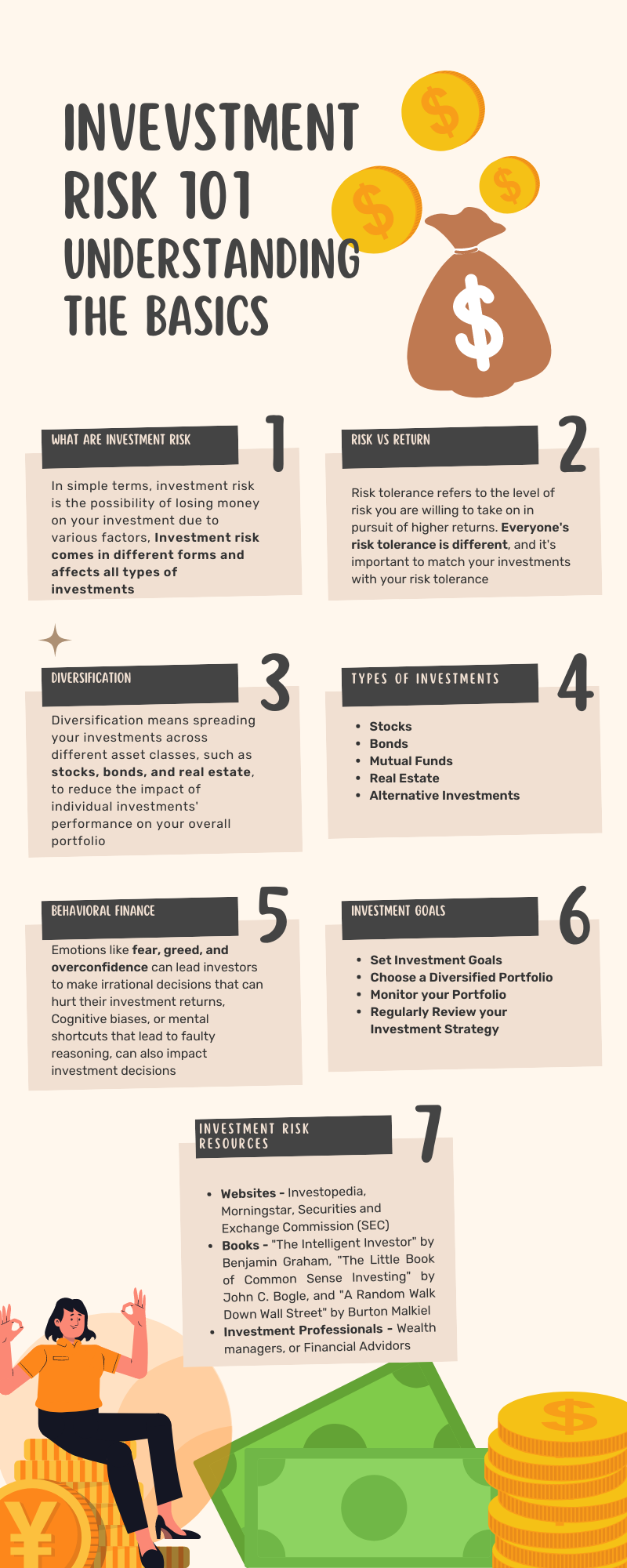Are you thinking about investing your hard-earned money, but not sure where to start? The world of investing can be complex and intimidating, especially when it comes to understanding investment risks. But don’t worry, I’ve got you covered with our Investment Risk 101 guide.
Investment risk is the chance that an investment’s actual return will be different than what is expected. Every investment carries some level of risk, and it’s essential to understand the different types of risks that come with various investment options. This understanding will help you make informed decisions that align with your financial goals and risk tolerance.
In this guide, I’ll take a deep dive into the basics of investment risks. I’ll cover the various types of risks that come with investing, such as market risk, credit risk, and inflation risk. I’ll also explain the critical relationship between risk and return, and why diversification is crucial in managing investment risks.
Investing can be a powerful tool for building wealth, but it’s crucial to understand the risks that come with it. This Investment Risk 101 guide will equip you with the knowledge and skills you need to make informed investment decisions and build a successful investment portfolio. So, let’s get started on your journey to smarter investing!
What Are Investment Risks
Are you new to the world of investing and feeling overwhelmed by the different terms and jargon?
One of the most critical concepts to understand when it comes to investing is investment risk. In simple terms, investment risk is the possibility of losing money on your investment due to various factors.
Investment risk comes in different forms and affects all types of investments, from stocks and bonds to real estate and mutual funds.
Market risk is the most common type of investment risk, and it refers to the potential for an investment to lose value due to changes in the stock market.
Credit risk is the risk of default by a borrower, while inflation risk refers to the possibility that rising inflation may reduce the purchasing power of your investment over time.
It’s essential to understand the different types of investment risks before making any investment decisions. The level of risk associated with an investment will determine the potential return and the chance of losing money. Therefore, it’s crucial to match your investments with your risk tolerance and financial goals.
By understanding the different types of investment risks, you can make informed decisions and build a diversified investment portfolio that aligns with your financial goals and risk tolerance.
Don’t let investment risks scare you away from investing. With the right knowledge and approach, you can navigate investment risks and build a successful investment portfolio.
Risk Vs Return
Have you ever heard the saying, “no risk, no reward”? The concept of risk versus return is one of the most fundamental principles of investing.
The relationship between risk and return is simple – the greater the risk, the greater the potential return.
However, it’s important to understand that risk and return are interconnected, and as an investor, you must determine your risk tolerance before making investment decisions.
Risk tolerance refers to the level of risk you are willing to take on in pursuit of higher returns. Everyone’s risk tolerance is different, and it’s important to match your investments with your risk tolerance.
For example, if you have a low risk tolerance, you may prefer to invest in bonds or other fixed-income investments that have a lower risk profile but offer a lower potential return. On the other hand, if you have a higher risk tolerance, you may be more comfortable investing in stocks or other high-risk investments that have the potential for higher returns.
It’s important to note that risk and return are not always directly proportional. Some investments may have a higher risk but offer a lower potential return, while others may have a lower risk but offer a higher potential return. Therefore, it’s crucial to do your research and seek professional advice before making any investment decisions.
By understanding the relationship between risk and return and your own risk tolerance, you can make informed investment decisions that align with your financial goals and help you build a successful investment portfolio.
Diversification
Have you ever heard the saying, “don’t put all your eggs in one basket”? The same principle applies to investing, and diversification is a key strategy for managing investment risks.
Diversification means spreading your investments across different asset classes, such as stocks, bonds, and real estate, to reduce the impact of individual investments’ performance on your overall portfolio.
By diversifying your investments, you can reduce the overall risk of your portfolio while potentially increasing returns.
If you invest all your money in one company or industry, you are at a higher risk of losing your entire investment if that company or industry experiences a downturn.
However, by diversifying your investments across different industries and asset classes, you can spread your risk and reduce the impact of any one investment on your overall portfolio.
Diversification can also help you capture the potential upside of different investments. If one investment is performing poorly, the returns from other investments in your portfolio may help offset those losses. This can help you weather market downturns and maintain a more stable investment portfolio.
It’s important to note that diversification does not guarantee profits or protect against loss. However, it is a fundamental risk management strategy that can help you build a more resilient investment portfolio.
By diversifying your investments, you can reduce the overall risk of your portfolio while potentially increasing returns, making it a crucial strategy for any investor to consider.
Types Of Investments And Their Risks
Investing can be a great way to grow your wealth, but it’s important to understand the risks associated with different types of investments.
Here are some of the most common types of investments and the risks associated with each:
Stocks – Stocks are ownership stakes in companies, and their value can fluctuate based on a variety of factors, including the overall health of the economy and the company’s financial performance.
Bonds – Bonds are debt securities issued by corporations or governments, and they are generally considered less risky than stocks. However, bond values can still fluctuate based on factors like interest rates and the creditworthiness of the issuer.
Mutual Funds – Mutual funds are investment vehicles that pool money from multiple investors to invest in a diversified portfolio of stocks, bonds, or other assets. The risks associated with mutual funds depend on the types of investments they hold.
Real Estate – Real estate can be a great investment, but it comes with risks like property damage, market fluctuations, and the potential for tenants to default on rent payments.
Alternative Investments – Alternative investments like cryptocurrencies, commodities, and hedge funds can offer potentially high returns, but they are often highly volatile and carry significant risks.
It’s important to research the risks associated with any investment before making a decision. As an investor, you should also consider your risk tolerance and financial goals before choosing which types of investments to pursue.
By understanding the risks associated with different types of investments, you can make informed decisions and build a diversified investment portfolio that aligns with your financial goals and risk tolerance.
Behavioral Finance
When it comes to investing, emotions and cognitive biases can play a significant role in decision-making.
This field of study is known as behavioral finance, and it focuses on how psychological factors can impact investment choices.
Emotions like fear, greed, and overconfidence can lead investors to make irrational decisions that can hurt their investment returns.
For example, investors may be tempted to sell their investments during a market downturn out of fear, rather than staying the course and waiting for the market to recover.
Cognitive biases, or mental shortcuts that lead to faulty reasoning, can also impact investment decisions. For instance, the confirmation bias can lead investors to seek out information that confirms their preconceived notions about an investment, while ignoring information that contradicts their views.
By understanding your own emotions and cognitive biases, you can make more informed investment decisions.
For example, if you know that you tend to be overconfident in your investment choices, you can take steps to mitigate that bias by seeking out diverse opinions and conducting thorough research before making a decision.
It’s also important to recognize the impact of external factors, such as media coverage and social influence, on your investment decisions. By staying informed and maintaining a long-term perspective, you can make investment decisions that are grounded in rational analysis rather than emotional reactions.
Overall, understanding the role of emotions and cognitive biases in investment decision-making can help you make better investment choices that align with your long-term financial goals.
Investment Planning
Investment planning is an essential part of building a successful investment portfolio. Here are some practical tips to help you get started:
- Set investment goals – Before you start investing, it’s important to have clear investment goals in mind. Do you want to save for a down payment on a house, or are you investing for long-term retirement savings? Knowing your goals will help you make informed investment decisions.
- Choose a diversified portfolio – Diversification is a key risk management strategy that involves investing in a variety of asset classes, such as stocks, bonds, and real estate. This helps to spread out your risk and reduce the impact of any individual investment on your overall portfolio.
- Monitor your portfolio – Once you’ve built your investment portfolio, it’s important to keep a close eye on it. Regularly monitoring your portfolio can help you identify any changes that may be necessary, such as rebalancing your asset allocation or adjusting your investment strategy based on market conditions.
- Regularly review your investment strategy – As your financial goals and life circumstances change, it’s important to regularly review and adjust your investment strategy. This can help ensure that your investments continue to align with your long-term financial goals.
By following these practical tips, you can create a sound investment plan that helps you achieve your financial goals while managing risk.
Remember, investing is a long-term game, and the key to success is patience, discipline, and a commitment to monitoring and adjusting your investment strategy as needed.
Investment Risk Resources
Investing can be a complex and sometimes daunting undertaking, particularly when it comes to understanding and managing investment risks.
Fortunately, there are a wide range of resources available that can help investors better navigate the world of investing. Here are some resources to consider:
- Websites – There are a number of websites that offer valuable resources on investment risks, such as Investopedia, Morningstar, and the Securities and Exchange Commission (SEC). These websites offer information on topics like risk management strategies, investment products, and regulatory information.
- Books – There are also a variety of books available on investment risk that can help investors deepen their knowledge and understanding of the topic. Some popular titles include “The Intelligent Investor” by Benjamin Graham, “The Little Book of Common Sense Investing” by John C. Bogle, and “A Random Walk Down Wall Street” by Burton Malkiel.
- Investment professionals – Finally, investors may want to consider working with an investment professional, such as a financial advisor or wealth manager. These professionals can offer personalized guidance and expertise on investment risks, as well as help investors develop a customized investment strategy that aligns with their financial goals.
By utilizing these resources, investors can gain a deeper understanding of investment risks and develop a sound investment strategy that helps them achieve their long-term financial goals.
Conclusion
Investing is an essential part of building wealth and achieving financial freedom, but it’s important to remember that investing always involves some degree of risk.
Understanding investment risks is critical to making informed investment decisions, and managing those risks is key to building a successful investment portfolio.
Throughout this article, I’ve covered a range of topics related to investment risks, from the basics of risk and return to the importance of diversification and the role of behavioral finance in investment decision-making.
I’ve also provided resources that investors can use to deepen their knowledge and understanding of investment risks, such as websites, books, and investment professionals.
As you move forward with your own investment journey, it’s important to remember some key points. First, be sure to set clear investment goals and align your investments with those goals.
Second, understand your own risk tolerance and choose investments that align with your comfort level.
Third, regularly monitor and review your investment strategy to ensure it remains aligned with your long-term goals.
Finally, don’t be afraid to explore new investment opportunities and continue learning about the world of investing. With the right knowledge, strategy, and mindset, you can successfully manage investment risks and build a portfolio that helps you achieve your financial goals.






